What is a Paper Wallet?
A cryptocurrency paper wallet is just a hard copy piece of paper containing a private key that is associated to a public key that is in turn associated with an address that confirms ownership of a given cryptocurrency and allows you to store, transfer and transact that cryptocurrency.
A cryptocurrency paper wallet is a form of cold wallet storage or rather, one that is used offline when accessing your digital cryptocurrency funds and is therefore considered more secure than other wallets that are connected to the internet continually or intermittently when being used. This is because the private key is not saved online or on someone else's computer and you are free from the dangers of hacking and malware infections that target at stealing your private key.
The said private key creates a public key that creates the address in turn when you are accessing your funds on a cryptocurrency software client. You basically scan a code or input a number on the paper into the client in order to gain access to your funds. Thus, with your key and paper, you are the only one who gains access to your funds in order to spend or transfer them.
It means you can trust paper wallets to keep large amounts of cryptocurrency for a long period. Of course, you will need to store or lock or save the paper in a secure place and protect it from physical damage and natural wear and tear.
Paper wallets are very helpful for beginners in crypto trading and dealings because no special tech skills needed to generate and run them. They are also very helpful for those dealing with large amounts of crypto for a long period.
Setting up a crypto paper wallet
Data in a paper wallet is written both in the form of a QR code that can be scanned in future when doing transactions and in numbers that you can read and write. You simply scan the code shown on the paper or key in the key into a software client to gain access to your money.
Paper wallets are generated offline using open source programs that come with ability to randomize the numbers or addresses. The program is then deleted from the computer after generating the wallet. It is recommended to use a computer that is not affected by virus, probably a brand new computer.
There are various programs used to generate these wallets. A good place to start would be the official paper wallet generator of the cryptocurrency you intend to deal in; for instance, BitAddress helps you generate a Bitcoin paper wallet. For Ethereum, visit MyEtherWallet.com and follow the steps to generate a paper wallet for Ethereum. They also provide tips on how to save and use the wallet offline. You can also visit LiteAddress.org for Litecoin paper wallets.
You can generate paper wallets for 150 different cryptocurrencies using WalletGenerator.net. Ethereum is not supported, so visit MyEtherWallet.com.
To do set up a wallet with WalletGenerator.net, visit the website, download the website from GitHub and open the index.html file directly on your computer. The file has 6000 plus lines of javascript code. Make sure it is not online or no malicious code is inserted in the file to leak your private key!
Choose the currency and click on "Generate new address" button to generate a new address. You can type in some random numbers into the address of hover the mouse on the address to generate a random number or randomize each of the figures. Print the paper. Delete saved web page. Make multiple copies of the numbers from it or of the paper itself and keep in separate places.
With the Ethereum wallet, you create a new password and generate your wallet, then download a keystore file that is your wallet file. Keep a back up of this file.
Spending and transferring cryptocurrency with paper wallets
Transferring crypto to a paper wallet is easy. For instance, you just open the live wallet software such as Bitcoin-Qt or Electrum or Mycelium) or web-based wallet (e.g. blockchain.info, coinbase.com) and then transfer the funds to the public address shown on your paper wallet.
You can also transfer crypto from a paper to a live wallet by simply "sweeping" or "importing" your paper. It is advisable to sweep the entire balance as it is not safe to try spending crypto directly from the paper wallet. You will, however, require importing the paper wallet private key to a software wallet (which can be done offline) and scanning the code.
If the interest is sending the crypto to another person, you could try first sending the crypto to your software wallet. With blockchain.info, you can either use the import private key option or the scan with webcam option to import your paper wallet private key. You then send the funds to an address owned by the other person or recipient and since you have to sweep the entire balance, you can consider sending the rest to an address on your desktop client.
Do not reveal the private key until you are ready to import the balance on the wallet to a client, exchange or online wallet.
When using the code on the paper to access funds, any wallet that has an "import private key" feature will accept the code to be scanned and most do. For those with BIP38-encrypted paper wallets, you will need to first use the "Validate" feature on the generator to extract the unencrypted Wallet Import Format (WIF) key as an intermediate step before sweeping the balance. Many Bitcoin wallets will not allow a direct import without extracting first.
Risks associated with paper wallets
Although there is a lesser risk to hacking, there are other risks: once the paper gets wiped, that's it. You lose your money if you do not have key recovery methods in place!
For instance, beware of people using coercion to have your key. Paper is also fragile and can be damaged. As a physical property, it can be stolen or destroyed by disasters and weather exposure. You might also forget it somewhere. The paper might also get ruined if it gets wet. Store in a sealed plastic bag or pocket.
It is advisable to store them in multiple copies in multiple secure locations, sometimes in a lock and key safe.
Because of the importance of a paper wallet and the fact that you can easily lose money when you lose the key, it is important to put into place mechanisms that will help restore the key once the damage is done. It is possible.
Restoring a lost paper wallet
You can import all the data on the paper wallet to your online desktop software wallet client. It is advisable to use a separate computer that will never get connected to the internet for as long as it has your private key.
Any software wallet client that supports importing private keys will work. For most of the wallet, the process is simple and intuitive.
With Bitcoin Unlimited wallet, for instance, open the wallet client and click "Help," select the Debug Window and click on the Console tab. Type “importprivkey” Replace with your private key and remove quotation marks. Hit enter and you are done.
Further resources:
There is a very good step-by-step guide here on how to set up and use a Bitcoin paper wallet in transacting cryptocurrency. There is another step-by-step guideline here.







